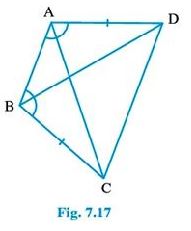Class 9 - Mathematics
Triangles - Exercise 7.1

Top Block 1
Exercise 7.1
Question : 1 In quadrilateral ACBD,AC = AD and AB bisects ∠ A (see Fig. 7.16). Show that Δ ABC ≅Δ ABD.
What can you say about BC and BD?

Answer :
In Δ ABC and Δ ABD, we have
AC = AD [Given]
∠CAB = ∠DAB [Since AB bisects ∠A]
AB = AB [Common]
So, Δ ABC ≅ Δ ABD [By SAS congruence]
Therefore, BC = BD [By CPCT]
Question : 2: ABCD is a quadrilateral in which AD = BC and ∠ DAB = ∠ CBA (see Fig. 7.17).

Mddle block 1
Prove that
(i) Δ ABD ≅Δ BAC
(ii) BD = AC
(iii) ∠ ABD = ∠ BAC.
Answer :
(i) In quadrilateral ABCD, we have AD = BC and ∠DAB = ∠CBA.
In ΔABD and ΔBAC,
AD = BC [Given]
AB = BA [Common]
∠DAB = ∠CBA [Given]
Using SAS criteria, we have
ΔABD ≌ΔBAC
(ii) Since ΔABD ≌ΔBAC
So, their corresponding parts are equal.
⇒ BD = AC
(ii) Since ΔABD ≌ΔBAC
So, their corresponding parts are equal.
⇒ ∠ABD = ∠BAC.
Question : 3: AD and BC are equal perpendiculars to a line segment AB (see Fig. 7.18). Show that CD bisects AB.

Answer :
We have ∠ABC = 900 and ∠BAD = 900
Also AB and CD intersect at O.
So, vertically opposite angles are equal.
Now, in ΔOBC and ΔOAD, we have
∠ABC = ∠BAD [each = 900]
BC = AD [Given]
∠BOC = ∠AOD [vertically opposite angles]
Using ASA criteria, we have
ΔOBC ≌ΔOAD
⇒ OB = OA [By CPCT]
i.e. O is the mid-point of AB
Thus, CD bisects AB.
Question : 4: l and m are two parallel lines intersected by another pair of parallel lines p and q (see Fig. 7.19). Show that Δ ABC ≅ Δ CDA.

Answer :
Since l || m and AC is a transversal.
So, ∠BAC = ∠DCA [Alternate interior angles]
Also p || q and AC is a transversal,
So, ∠BCA = ∠DAC [Alternate interior angles]
Now, in ΔABC and ΔCDA,
∠BAC = ∠DCA [Proved]
∠BCA = ∠DAC [Proved]
CA = AC [Common]
Using ASA criteria, we have
ΔABC ≌ΔCDA
Question : 5: line l is the bisector of an angle ∠ A and B is any point on l. BP and BQ are perpendiculars from B to the arms of ∠ A (see Fig. 7.20).
Show that:
(i) Δ APB ≅Δ AQB
(ii) BP = BQ or B is equidistant from the arms of ∠ A.

Answer :
We have, l as the bisector of QAP.
So, ∠QAB = ∠PAB
∠Q = ∠P [each = 900]
⇒ Third ∠ABQ = Third ∠ABP
(i) Now, in ΔAPB and ΔAQB, we have
AB = AB [Common]
∠ABP = ∠ABQ [Proved]
∠PAB = ∠QAB [Proved]
Using SAS criteria, we have
ΔAPB ≌ΔAQB
(ii) Since ΔAPB ≌ ΔAQB
So, their corresponding angles are equal.
⇒ BP = BQ
i.e. Perpendicular distance of B from AP = Perpendicular distance of B from AQ
Thus, the point B is equidistant from the arms of ∠A.
Question : 6: In Fig. 7.21, AC = AE, AB = AD and ∠ BAD = ∠ EAC. Show that BC = DE.

Answer :
We have ∠BAD = ∠EAC
Adding ∠DAC on both sides, we have
∠BAD + ∠DAC = ∠EAC + ∠DAC
⇒ ∠BAC = ∠DAE
Now, in ΔABC and ΔADE, we have
∠BAC = ∠DAE [Proved]
AB = AD [Given]
AC = AE [Given]
So, ΔABC ≌ΔADE [Using SAS criteria]
Since ΔABC ≌ΔADE, therefore, their corresponding parts are equal.
⇒ BC = DE.
Question : 7: AB is a line segment and P is its mid-point. D and E are points on the same side of AB such that
∠ BAD = ∠ ABE and ∠ EPA = ∠ DPB
(see Fig. 7.22). Show that
(i) Δ DAP ≅Δ EBP
(ii) AD = BE

Answer :
We have, P is the mid-point of AB.
AP = BP
∠EPA = ∠DPB [Given]
Adding ∠EPD on both sides, we get
∠EPA + ∠EPD = ∠DPB + ∠EPD
∠APD = ∠BPE
(i) Now, in ΔDAP ≌ΔEBP, we have
AP = BP [Proved]
∠PAD = ∠ PBE [It is given that ∠BAD = ∠ABE]
∠DPA = ∠EPB [Proved]
Using ASA criteria, we have
ΔDAP ≌ΔEBP
(ii) Since ΔDAP ≌ΔEBP
So, their corresponding parts are equal.
⇒ AD = BE.
Question : 8: In right triangle ABC, right angled at C, M is the mid-point of hypotenuse AB. C is joined to M and produced to a point D such that
DM = CM. Point D is joined to point B (see Fig. 7.23).
Show that:
(i) Δ AMC ≅Δ BMD
(ii) ∠ DBC is a right angle.
(iii) Δ DBC ≅Δ ACB
(iv) CM = AB/2

Answer :
Since M is the mid-point of AB.
So, BM = AM [Given]
(i) In ΔAMC and ΔBMD, we have
CM = DM [Given]
AM = BM [Proved]
∠AMC = ∠BMD [Vertically opposite angles]
So, ΔAMC ≌ΔBMD [SAS criteria]
(ii)Since ΔAMC ≌ΔBMD
So, their corresponding parts are equal.
⇒ ∠MAC = ∠MBD
But they form a pair of alternate interior angles.
So, AC || DB
Now, BC is a transversal which intersecting parallel lines AC and DB,
So, ∠BCA + ∠DBC = 1800
But ∠BCA = 900 [Since ΔABC is right angled at C]
⇒ 900 + ∠DBC = 1800
⇒ ∠DBC = 1800– 900
⇒ ∠DBC = 900
(iii) Again, ΔAMC ≌ΔBMD [Proved]
So, AC = BD [by CPCT]
Now, in ΔDBC and ΔACB, we have
∠DBC = ∠ACB [Each = 900]
BD = CA [Proved]
BC = CB [Common]
Using SAS criteria, we have
ΔDBC ≌ΔACB
(iv) Since ΔDBC ≌ΔACB
So, their corresponding parts are equal.
⇒ DC = AB
But DM = CM [Given]
So, CM = DC/2 = AB/2
⇒ CM = AB/2

